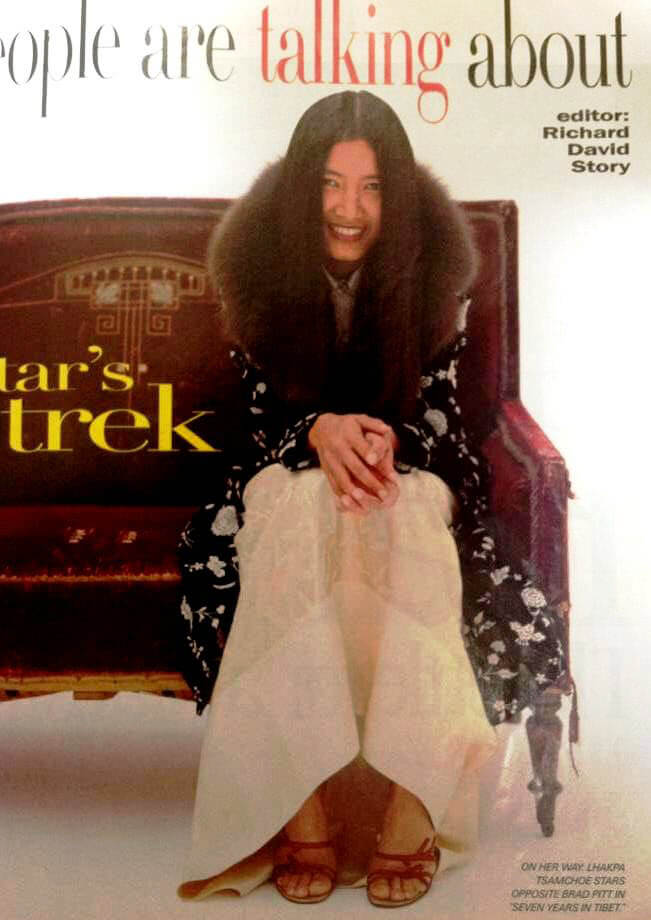Tibetan Princess in Hollywood
 by Alex Luu, in Yolk (2001) 41(4)
by Alex Luu, in Yolk (2001) 41(4)
“I never dreamt I would be acting,” Lhakpa Tsamchoe says. “I was just taking some computer classes after my college graduation and this casting agent approached me.” Tsamchoe, starring in the new Kino International release Himalaya, is reminiscing about her “accidental” tripp into the Hollywood spotlight a few years ago, when she was plucked out of obscurity while dancing with friends at a disco to star opposite Brad Pitt in Seven Years In Tibet. As happenstance as it may sound, Tsamchoe’s journey to Hollywood is anything but accidental. Talk to her more than a few minutes and a closer glimpse into her history reveals a higher force at hand, a spiritual guidance if you will, that has steered Tsamchoe’s life.
When Tsamchoe speaks, there is an undeniable tone of world-weariness in her deep voice, yet her incredibly large eyes dance with glee and contentment. Her beauty is unforced, a natural effervescence that is at once got gorgeous and classy. Her full lips seem to have a life of their own, turning up into a delightful smirk both mischievous and soothing. Tsamchce holds a Bachelor of Science degree in Chemistry, Botany, and Zoology. Her impressive academic achievements are punctuated by a childhood rich with culture, history, and an enduring legacy of oppression. Her parents fled Tibet in the 60’s when Chinese government forces cracked down on the Tibetan people, killing close to 100,000 Tibetans and burning Tibetan property and monasteries. They resettled in the Tibetan resettlement community of Bylakuppe in South India, where Tsamchoe was born and raised. “It was a very difficult journey when my parents first came to South India,’ Tsamchoe says. “Even though India gave Tibetans land, it was all forest so they had to cut down the trees to build a house and grow corn in the fields. A few people got killed by wild elephants.” Barely beginning her acting career (Himalaya is only her second film), Tsamchoe is somewhat of an anomaly—an intelligent woman with breathtaking good looks who chooses projects leisurely based on what the script speaks to her on a spiritual level. Not exactly what Hollywood usually gravitates toward in an industry numb with copycat formulas of stupid TV shows and movies populated by Monde-haired, blue-eyed hunks and starlets. Ironically, it is precisely Tsamchoe’s individualism and unique life perspective that brought her to the big screen in the first place. “There was a Tibetan function in Bangalore City where I was studying at the time,” Tsamchoo recalls. “That evening there was a dance party at this disco. The casting agent for Seven Years In Tibet came up to me and asked me to come in for an interview. It ended up lasting for 3 hours; they asked about my background and shot a video and took photographs. Two weeks later I was asked to go to London for a screen test. It was my first time flying out of India!”
Her breakthrough performance in Tibet met with critical acclaim and Tsamchoe found herself navigating the unpredictable waters of Hollywood. Refusing to get caught up in the lifestyle of self-indulgence and self-worship in Los Angeles, Tsamchoe makes her home in Breckenridge, Colorado. “I don’t think I’ll be happy when I’m in LA,” Tsamchoe offers. “Here in Colorado, I see all the mountains and there’s not too much happening here. I do meditation and attend my Buddhist philosophy classes. I go walking and hiking around the hills.” In addition to living life day by day, Tsamchoe is a proponent for human rights of Tibetans. “When I was in high school and college my feelings for Tibetan people surfaced more and more,” Tsamchoe says. “I became more aware when I first saw documentaries of the Chinese beating Tibetans and seeing*Tibetan monks who have been imprisoned 20-30 years. I also remember sitting with h my father and hearing him tell stories of how Tibet used to be before the Chinese caused all the destruction. I see aU of that and my heart breaks.” Tsamchoe’s immediate family has long been politically active in the cause for Tibet. “My father is a State Senator in India for Tibetan people. He was elected by the Tibetan people. My mother is Vice President of Tibetan Women’s Association; when I was a student in college I was the Secretary of Tibetan Youth Congress.”
Tsamchoe’s involvement with Himalaya also stems from her sense of activism and need to portray the Tibetan culture to a main-stream atidience. Set in the Dolpo region of Nepal, the Eric Valli-directed film centers around a power and spiritual struggle amongst an ancient tribe over a yak caravan across the treacherous peaks of the Himalayas. “The shoot was more difficult than the Tibet one,” Tsamchoe reflects. “There were no roads, no electricity and no car; there were none of the comforts at home. We were there seven months. After the first part of shooting some of the crew members went home for Christmas and a lot of them didn’t come back. Everyone cried, even the men. But it was an incredible rich and rewarding experience. I really felt like I saw the real Tibet while shooting Himalaya.”
And what about her performance amidst the harsh physical conditions? “My character in Himalaya was much harder for me,” Tsamchoe says. “This one has more conflict and sadness whereas the woman I played in Tibet was closer to me—jolly, light and fun.” Tsamchoe also credits Himalaya for giving more ammunition to her arsenal of adventure and resilience. “After going through the shoot, you can do anything in life if you work hard enough and put your whole heart into it. It was a spiritual journey.”
With all the rich life experiences outside of Hollywood, Tsamchoe is in no hurry to compromise her integrity and philosophy for just any part in the next movie. “My maturity and respect for community and elders has a lot to do with my parents,” Tsamchoe says. “My basic foundation as a person conies from them and my other Tibetan friends I’ve met some truly good people up to now. In my previous life I must have done something very good.”
Star’s Trek
 in Vogue (October, 1997)
in Vogue (October, 1997)
Seven Years in Tibet is the classic account of Austrian mountain climber Heinrich Harrer’s 1944 escape from a British prisoner-of-war camp during World War II and his harrowing trek across the Himalayas to Lhasa, where he became the Dalai Lama’s tutor. Actress Lhakpa Tsamchoe, who plays opposite Brad Pitt in Jean-Jacques Annaud’s epic, comes from a family that trekked across the Himalayas—but in the other direction (and before the People’s Liberation Army took over Lhasa). With her long, shiny black hair in a cascade of Tibetan-style plaits that took seven hours to braid each day, Tsamchoe looks very much the traditional Tibetan she is at heart. Before the first day of filming, she asked her mother to pray for her in the local Tibetan Buddhist monastery; Tsamchoe herself prays for people she likes, for people she doesn’t, and for the Dalai Lama. These days, she says, “I also offer thanks for the help given to our director, Jean-Jacques, to Brad, and to all the cast and crew.” [continued]

